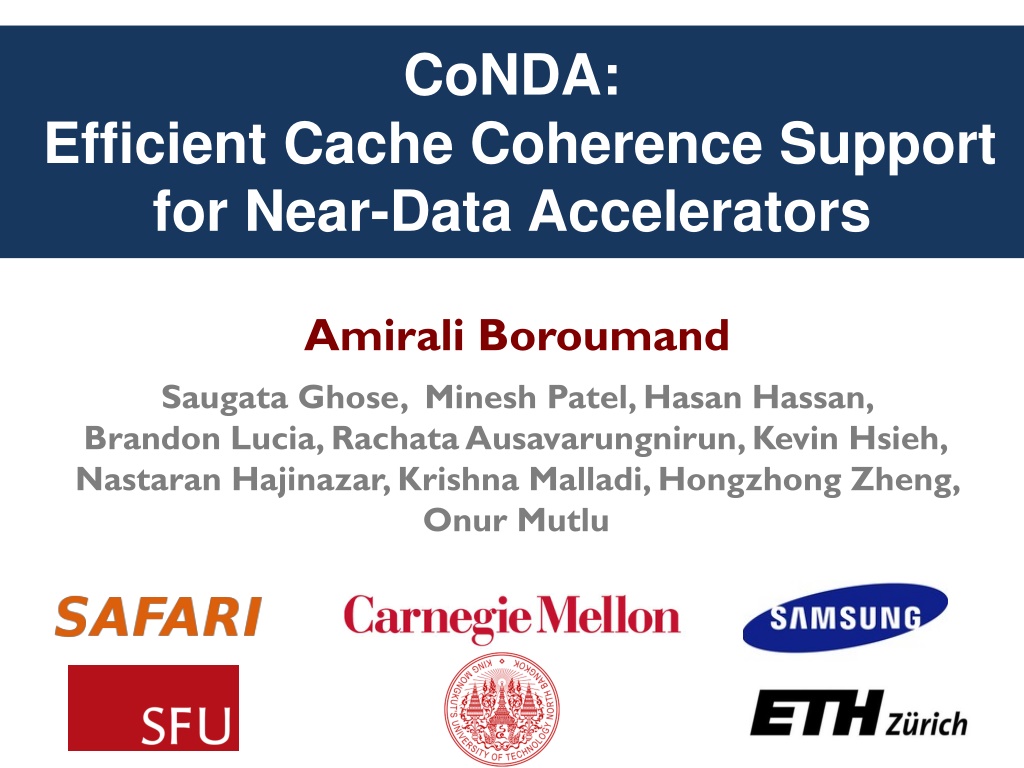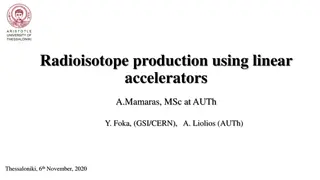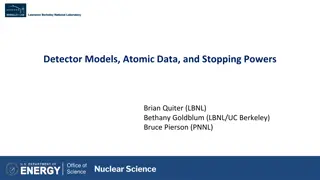Optimizing Coherence Mechanisms for Near-Data Accelerators
Coherence mechanisms play a crucial role in supporting efficient communication between Near-Data Accelerators (NDAs) and CPUs. The CoNDA framework introduces an optimistic approach to coherence, aiming to reduce unnecessary off-chip data movement and enhance performance. By gaining insights before coherence checks and executing only essential coherence requests, CoNDA shows promising results in improving efficiency while addressing the challenges associated with NDA coherence.
Download Presentation

Please find below an Image/Link to download the presentation.
The content on the website is provided AS IS for your information and personal use only. It may not be sold, licensed, or shared on other websites without obtaining consent from the author. Download presentation by click this link. If you encounter any issues during the download, it is possible that the publisher has removed the file from their server.
E N D
Presentation Transcript
CoNDA: Efficient Cache Coherence Support for Near-Data Accelerators Amirali Boroumand Saugata Ghose, Minesh Patel, Hasan Hassan, Brandon Lucia, RachataAusavarungnirun, Kevin Hsieh, Nastaran Hajinazar, Krishna Malladi, Hongzhong Zheng, Onur Mutlu
Specialized Accelerators Specialized accelerators are now everywhere! ASIC NDA GPU FPGA ASIC Recent advancement in 3D-stacked technology enabled Near-Data Accelerators (NDA) DRAM CPU NDA ASIC 2
Coherence For NDAs Challenge: Coherence between NDAs and CPUs (1) Large cost of off-chip communication DRAM CPU L2 CPU CPU CPU L1 Compute Unit (2) NDA applications generate a large amount of off-chip data movement NDA ASIC It is impractical to use traditional coherence protocols 3
Existing Coherence Mechanisms We extensively study existing NDA coherence mechanisms and make three key observations: 1 These mechanisms eliminate a significant portion of NDA s benefits 2 The majority of off-chip coherence traffic generated by these mechanisms is unnecessary Much of the off-chip traffic can be eliminated if the coherence mechanism has insight into the memory accesses 3 ASIC 4
An Optimistic Approach We find that an optimistic approach to coherence can address the challenges related to NDA coherence 1 Gain insights before any coherence checks happen 2 Perform only the necessary coherence requests We propose CoNDA, a coherence mechanism that lets an NDA optimistically execute an NDA kernel Optimistic execution enables CoNDA to identify and avoid unnecessary coherence requests CoNDA comes within 10.4% and 4.4% of performance and energy of an ideal NDA coherence mechanism ASIC 5
Outline Introduction Background Motivation CoNDA Architecture Support Evaluation Conclusion 6
Background Near-Data Processing (NDP) A potential solution to reduce data movement Idea: move computation close to data Reduces data movement Exploits large in-memory bandwidth Exploits shorter access latency to memory Enabled by recent advances in 3D-stacked memory 7
Outline Introduction Background Motivation CoNDA Architecture Support Evaluation Conclusion 8
Sharing Data between NDAs and CPUs Hybrid Databases (HTAP) Graph Processing We find not all portions of applications benefit from NDA 1 Memory-intensive portions benefit from NDA 2 Compute-intensive or cache friendly portions should remain on the CPU 1st key observation: CPU threads often concurrently access the same region of data that NDA kernels access which leads to significant data sharing ASIC 10
Shared Data Access Patterns 2nd key observation: CPU threads and NDA kernels typically do not concurrently access the same cache lines For Connected Components application, only 5.1% of the CPU accesses collide with NDA accesses CPU threads rarely update the same data that an NDA is actively working on ASIC 11
Analysis of NDA Coherence Mechanisms
Analysis of Existing Coherence Mechanism We analyze three existing coherence mechanisms: 1 Non-cacheable (NC) Mark the NDA data as non-cacheable 2 Coarse-Grained Coherence (CG) Get coherence permission for the entire NDA region 3 Fine-Grained Coherence (FG) Traditional coherence protocols ASIC 13
Analysis of Existing Coherence Mechanisms CPU-only NC CG FG Ideal-NDA 2.0 Normalized Energy 2.0 Speedup 1.5 1.5 1.0 1.0 0.5 0.5 0.0 0.0 GMEAN CC Radii PR CC Radii PR GMEAN arXiV Gnutella Loses a significant portion of the performance and energy benefits Increases energy over CPU-only by 64.4% and performs 6.0% worse than CPU-only Performs 0.4% worse than CPU-only Poor handling of coherence eliminates much CG unnecessarily flushes a large amount of dirty data FG suffers from high amount of unnecessary NC suffers from a large number of off-chip accesses from CPU threads off-chip coherence traffic of an NDA s performance and energy benefits 14
Motivation and Goal 1 Poor handling of coherence eliminates much of an NDA s benefits 1 2 The majority of off-chip coherence traffic is unnecessary 2 Our goal is to design a coherence mechanism that: 3 1 2 Retains benefits of Ideal NDA Enforces coherence with only the necessary data movement 15
Outline Introduction Background Motivation CoNDA Architecture Support Evaluation Conclusion 16
Optimistic NDA Execution We leverage two key observations: 1 unnecessary coherence traffic 2 Low rate of collision for CPU threads and NDA kernels Having insight enables us to eliminate much of We propose to use optimistic execution for NDAs NDA executes the kernel: 1 Assumes it has coherence permission 2 When execution is done: Gains insights into memory accesses ASIC Performs only the necessary coherence requests 17
High-Level Overview of Optimistic Execution Model CPU NDA Time CPU Thread Execution Concurrent CPU + NDA Execution Optimistic Execution No Coherence Request Coherence Resolution Commit or Re-execute 18
High-Level Overview of CoNDA We propose CoNDA, a mechanism that uses optimistic NDA execution to avoid unnecessary coherence traffic CPU NDA Time CPU Thread Execution Concurrent CPU + NDA Execution Optimistic Execution No Coherence Request Signature Signature Coherence Resolution 19
How do we identify coherence violations?
Necessary Coherence Requests Coherence requests are only necessary if: Both NDA and CPU access a cache line At least one of them updates it We discuss three possible interleaving of accesses to the same cache line: 1 NDA Read and CPU Write (coherence violation) 2 NDA Write and CPU Read (no violation) 3 NDA Write and CPU Write (no violation) ASIC 21
Identifying Coherence Violations TimeCPU NDA C1. Wr Z C2. Rd A C3. Wr B No coherence checks during NDA execution N1. Rd X N2. Wr Y N3. Rd Z 1) NDA Read and CPU Write: violation NDA reads old value of Z Any Coherence Violation? Yes. Flush Z to DRAM 2) NDA Write and CPU Read : no violation Coherence checks happen at the end of NDA kernel C4. Wr Y C5. Rd Y N4. Rd X N5. Wr Y N6. Rd Z 3) NDA Write and CPU Write: no violation C4 and C5 are ordered before N5 Any Coherence Violation? No. Commit NDA operations C6. Wr X 22
Outline Introduction Background Motivation CoNDA Architecture Support Evaluation Conclusion 23
CoNDA: Architecture Support DRAM CPU CPU L1 L1 NDA Core Shared LLC NDAReadSet NDAReadSet Coherence Resolution Resolution Coherence NDAWriteSet NDAWriteSet CPUWriteSet CPUWriteSet ASIC 24
Optimistic Mode Execution The CPU records all writes to the NDA data region in the CPUWriteSet CPU L1 L1 L1 NDA Core Core NDA Shared LLC NDAReadSet NDAReadSet NDAWriteSet NDAWriteSet Coherence Resolution CPUWriteSet CPUWriteSet Per-word dirty bit mask to mark all uncommitted data updates ASIC The NDAReadSet and NDAWriteSet are used to track memory accesses from NDA 25
Signatures Address h0 h1 hk-1 CPU 1 1 0 L1 0 1 1 L1 0 1 1 0 0 0 NDA Core Shared LLC NDAReadSet NDAReadSet NDAWriteSet NDAWriteSet Coherence Resolution CPUWriteSet CPUWriteSet Bloom filter based signature has two major benefits: Allows us to easily perform coherence resolution Allows for a large number of addresses to be stored within a fixed-length register ASIC 26
Coherence Resolution CPUWriteSet NDAReadSet Conflict CPU L1 L1 NDA Core Shared LLC NDAReadSet NDAReadSet NDAWriteSet Coherence Resolution Resolution Coherence CPUWriteSet CPUWriteSet If conflicts happens: The CPU flushes the dirty cache lines that match addresses in the NDAReadSet NDA invalidates all uncommitted cache lines Signatures are erased and NDA restarts execution NDA commits data updates If no conflicts: Any clean cache lines in the CPU that match an address in the NDAWriteSet are invalidated ASIC 27
Outline Introduction Background Motivation CoNDA Architecture Support Evaluation Conclusion 28
Evaluation Methodology Simulator Gem5 full system simulator System Configuration: CPU 16 cores, 8-wide, 2GHz frequency L1 I/D cache: 64 kB private, 4-way associative, 64 B block L2 cache: 2 MB shared, 8-way associative, 64 B blocks Cache Coherence Protocol: MESI NDA 16 cores, 1-wide, 2GHz frequency L1 I/D cache: 64 kB private, 4-way associative, 64 B Block Cache coherence protocol: MESI 3D-stacked Memory One 4GB Cube, 16 Vaults per cube 29
Applications Ligra Lightweight multithreaded graph processing We used three Ligra graph applications PageRank (PR) Radii Connected Components (CC) Real-world Input graphs: Enron arXiV Gnutella25 Hybrid Database (HTAP) In-house prototype of an in-memory database Capable of running both transactional and analytical queries on the same database (HTAP workload) 32K transactions, 128/256 analytical queries 30
Speedup CPU-only NDA-only FG CoNDA Ideal-NDA 66.0% 2.5 2.0 Speedup 1.5 1.0 0.5 0.0 CC Radii PR CC Radii PR CC Radii PR 128 256 GMEAN arXiV Gnutella Enron HTAP FG loses a significant portion of Ideal-NDA s improvement Ideal-NDA s improvement benefit of Ideal-NDA execution coming within 10.4% of the Ideal-NDA performance NDA-only eliminates 82.2% of CG and NC eliminate the entire performance CoNDA consistently retains most of Ideal-NDA s benefits, 31
Memory System Energy CPU-only FG CoNDA Ideal-NDA 1.25 Normalized Energy 1.00 0.75 0.50 0.25 0.00 CC Radii PR CC Radii PR CC Radii PR 128 256 GMEAN arXiV Gnutella Enron HTAP FG loses a significant portion of benefits because of a large number of off-chip coherence messages CoNDA significantly reduces energy consumption and comes within 4.4% of Ideal-NDA 32
Other Results in the Paper Results for larger data sets 8.4x over CPU-only 7.7x over NDA-only 38.3% over the best prior coherence mechanism Sensitivity analysis Multiple memory stacks Effect of optimistic execution duration Effect of signature size Effect of data sharing characteristics Hardware overhead analysis 512 B NDA signature, 2 kB CPU signature, 1 bit per page table, 1 bit per TLB entry, 1.6% increase in NDA L1 cache 33
Outline Introduction Background Motivation CoNDA Architecture Support Evaluation Conclusion 34
Conclusion Coherence is a major system challenge for NDA Efficient handling of coherence is critical to retain NDA benefits We extensively analyze NDA applications and existing coherence mechanisms. Major Observations: There is a significant amount of data sharing between CPU threads and NDAs A majority of off-chip coherence traffic is unnecessary A significant portion of off-chip traffic can be eliminated if the mechanism has insight into NDA memory accesses We propose CoNDA, a mechanism that uses optimistic NDA execution to avoid unnecessary coherence traffic CoNDA comes within 10.4% and 4.4% of performance and energy of an ideal NDA coherence mechanism 35
CoNDA: Efficient Cache Coherence Support for Near-Data Accelerators Amirali Boroumand Saugata Ghose, Minesh Patel, Hasan Hassan, Brandon Lucia, RachataAusavarungnirun, Kevin Hsieh, Nastaran Hajinazar, Krishna Malladi, Hongzhong Zheng, Onur Mutlu
Breakdown of Performance Overhead CoNDA s execution time consist of three major parts: (1) NDA kernel execution (2) Coherence resolution overhead (3.3% of execution time) (3) Re-execution overhead (8.4% of execution time) Coherence resolution overhead is low CPU-threads do not stall during resolution NDAWriteSet contains only a small number of addresses (6) Resolution mainly involves sending signatures and checking necessary coherence Overhead of re-execution is low The collision rate is low for our applications Re-execution is significantly faster than original execution 13.4% 38
Non-Cacheable (NC) Approach Mark the NDA data as non-cacheable Transactions Analytics (1) Generates a large number of off-chip accesses Hybrid Database (HTAP) (2) Significantly hurts CPU threads performance Transactions Analytics Data Sharing CPU CPU NDA NC fails to provide any energy saving and perform 6.0% worse than CPU-only ASIC 39
Coarse-Grained (CG) Coherence Get coherence permission for the entire NDA region Flush dirty data Unnecessarily flushes a large amount of dirty data, especially in pointer-chasing applications CPU CPU NDA Use coarse-grained locks to provide exclusive access CPU NDA Time Blocks CPU threads when they access NDA data regions STALL ASIC CG fails to provide any performance benefit of NDA and perform 0.4% worse than CPU only 40
Fine-Grained (FG) Coherence Using fine-grained coherence has two benefits: 1 Simplifies NDA programming model 2 Allows us to get permissions for only the pieces of data that are actually accessed (1) Memory-intensive (2) Poor locality High amount of off-chip coherence Traffic CPU CPU NDA FG eliminates 71.8% of the energy benefits of an ideal NDA mechanism 41
Memory System Energy NC suffers greatly from the large number of accesses to DRAM Interconnect and DRAM energy increase by 3.1x and 4.5x CPU-only NC CG FG CoNDA Ideal-NDA 3.1x 2.8x 2.2x 3.3x 2.4x 3.8x 3.1x 4.0x 2.3x 2.7x 1.25 Normalized Energy 1.00 0.75 0.50 0.25 0.00 CC CG and FG loses a significant portion of benefits because of large number of writebacks and off-chip coherence messages Radii PR CC Radii PR CC Radii PR 128 256 GMEAN arXiV Gnutella Enron HTAP CoNDA significantly reduces energy consumption and comes within 4.4% of Ideal-NDA 42
Speedup CPU-only NDA-only NC CG FG CoNDA Ideal-NDA 2.5 2.0 Speedup 1.5 1.0 0.5 0.0 FG loses a significant portion of Ideal-NDA s improvement CC CoNDA consistently retains most of Ideal-NDA s benefits, coming within 10.4% of the Ideal-NDA performance NDA-only eliminates 82.2% of Ideal-NDA s improvement Radii PR CC Radii PR CC Radii PR 128 256 GMEAN arXiV Gnutella CG and NC eliminate the entire benefit of Ideal-NDA execution Enron HTAP 43
Effect of Multiple Memory Stacks ASIC 44
Effect of Signature Size ASIC 46
Identifying Coherence Violations TimeCPU NDA Effective Ordering C1. Wr Z C2. Rd A C3. Wr B C1. Wr Z C2. Rd A C3. Wr B 2) NDA Write and CPU Read : no violation N1. Rd X N2. Wr Y N3. Rd Z 1) NDA Read and CPU Write: violation Any Coherence Violation? Yes. Flush Z to DRAM 3) NDA Write and CPU Write: no violation C4. Wr Y C5. Rd Y N4. Rd X N5. Wr Y N6. Rd Z C6. Wr X C4. Wr Y C5. Rd Y N4. Rd X N5. Wr Y N6. Rd Z Any Coherence Violation? No. commit NDA operations C6. Wr X 47
Optimistic NDA Execution We leverage two key observations 1 Majority of coherence 2 Enforce coherence with only the necessary data movement We propose to use optimistic execution for NDAs When executing in optimistic mode: An NDA gains insight into its memory accesses without issuing any coherence requests When optimistic mode is done: ASIC The NDA uses the tracking information to perform necessary coherence requests 48
Example: Hybrid Database (HTAP) Transactions Analytics Hybrid Database (HTAP) Transactions Analytics ASIC Data Sharing CPU CPU NDA 49
Application Analysis Wrap up 1 There is a significant amount of data sharing between CPU threads and NDAs 2 CPU threads and NDAs often do not access the same cache lines concurrently 3 CPU threads rarely update the same data that NDAs are actively working on ASIC 50






















